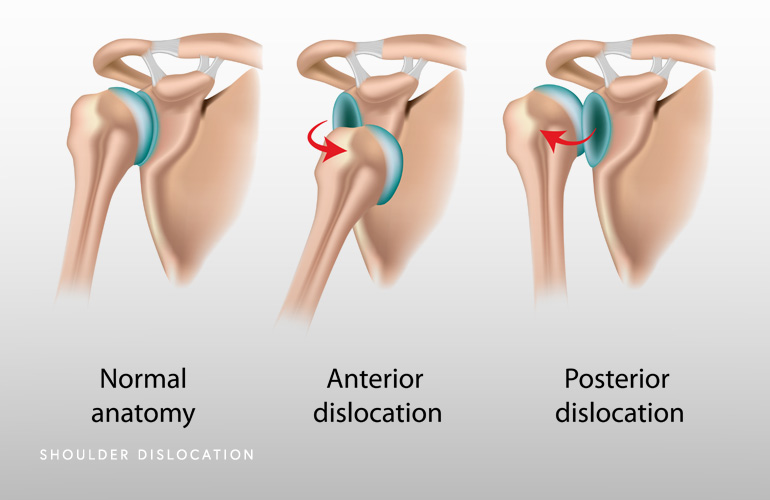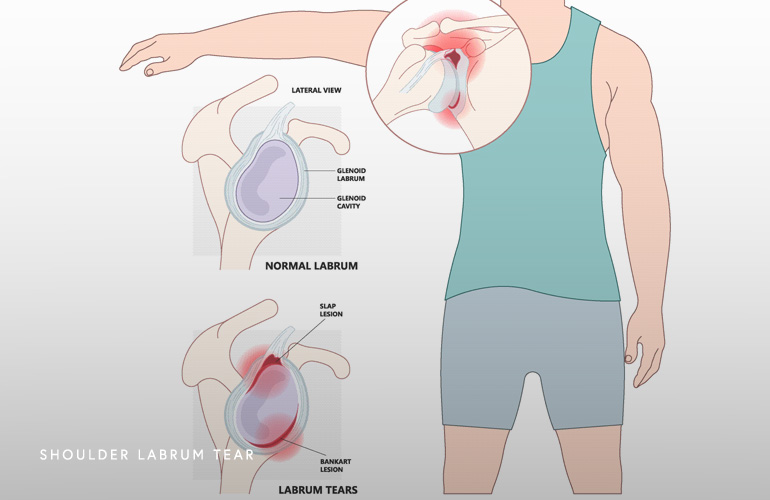Shoulder Instability
Instability of the shoulder or any joint refers to lack of stability or balance which leads to abnormal motion between the ball (humeral head) and socket (glenoid). The shoulder joint is unique in its dependence on soft tissue structures to keep the joint in place, instead of other more constrained ball-and-socket joints like the hip, which rely on the bony architecture with a full cup to hold the ball in position. The shoulder’s reliance on the soft tissues to hold the joint in position is adaptive because it provides for the greatest range of motion of any joint in the body but also leaves the joint susceptible to injury.
Specifically, shoulder instability results when the humeral head translates or slides in relation to the glenoid dish, instead of rotating. This sliding can occur along a spectrum, and in some conditions it is so mild it just causes pain and irritation and in others it slides partially out, just enough for the patient to feel a clunk or pop, called a subluxation. In more severe cases the humeral head completely slides out of the glenoid socket, a condition called a dislocation.

The glenoid socket of the shoulder is effectively a shallow dish, with an amount of depression at the surface similar to a golf tee. As noted previously, it is the soft tissues including the labrum, ligaments, and muscles, that provide a critical role in stabilizing the shoulder joint. The labrum acts almost like a thin cartilage bumper that runs in a circle around the glenoid socket and deepens the concavity of the socket. Further, the labrum is attached to connective tissue bands called ligaments that form a sheath around the joint. On top of this, a large overwrapping tendon called the rotator cuff allows muscle contraction to pull and hold the ball into the socket.

Because of the unique anatomic features of the shoulder, it is the most commonly dislocated joint in the body. Most commonly, the joint dislocates out the front of the socket called an anterior dislocation. Rarely, the joint can dislocate out the back called a posterior dislocation. Most dislocation events occur during injuries such as during athletic competition, car accidents, and falls. A shoulder dislocation is very painful and leaves the arm limp and unable to move. When this occurs, the shoulder has to be placed back into position. Some people that sustain a shoulder dislocation can pull the ball back into the socket themselves but others require assistance of an athletic trainer or emergency department provider to pull the joint back into place. When the shoulder is replaced, called “reduced”, the pain immediately improves and the arm is placed into a sling to protect it from further injury.
When the shoulder dislocates, the labrum in the front of the socket almost always tears. When the labrum tears, the ligaments attached to the labrum are no longer attached either. The socket cartilage lining and bone can be injured as well. In more severe cases, the socket bone is fractured. Usually, there is also a bruise in the back of the ball from the dislocated ball hitting back against the glenoid socket. The cartilage on the ball can also be damaged. In severe cases, the nerve around the shoulder can be stretched which leads to nerve injuries.
Because of the injury to the labrum and detachment of the ligaments with a dislocation, the shoulder is at risk of dislocating again. The shoulder dislocation can happen again in up to half of patients. While there are risk factors for dislocation recurrence such as in younger athletes, even if the shoulder does not fully dislocate again after healing the shoulder can feel unsteady and weak, particularly with overhead activities. Sometimes, there are patterns of injury to the cartilage and bone that are diagnosed on MRI that suggest the risk of re-dislocation is higher. If the shoulder continues to dislocate multiple times, the injury to the bones and cartilage continues to worsen, sometimes making treatment more complex and heightens the risk of arthritis later in life.
After a shoulder dislocation, especially after the first dislocation, the nonsurgical management foucuses on protecting the labrum and ligaments while they heal and strengthening the muscles of the rotator cuff. The rotator cuff compresses the ball into the socket, with a goal of improving the stability of the joint despite the injury to the primary tissues that hold the ball in position. Muscles that control the shoulder blade are also strengthened with physical therapy. It is important to avoid arm positions that commonly lead to dislocation. Usually the sling is removed after a few weeks and the patient can resume activities while therapy progresses. Often patients can transition to a home exercise program after approximately six weeks of physical therapy.
For patients sustaining the first dislocation with a substantial injury to the soft tissue or bone, or with a high risk of the dislocation happening again, surgery may be recommended. Surgery may also be recommended for patients sustaining multiple dislocation events. Risk factors including age less than 30 and athletic demands are considered at higher risk of recurrence of the dislocation and sometimes surgery is recommended. The surgery to repair the dislocating shoulder is a soft tissue repair using arthroscopy, or tiny poke holes non-invasively. Sometimes this surgery is referred to as Bankart repair, which refers to the name of the labrum in the front of the socket.
At the time of arthroscopic labrum repair shoulder surgery, Dr. Obermeyer uses high strength sutures which are attached to anchors which fix the labrum to the bone. Dr. Obermeyer uses the newest generation “knotless” suture anchors which avoid long term irritation from the suture material. The anchor is buried beneath the bone surface and the sutures stay in position after healing occurs, and are very well tolerated long term without the requirement for removing them.
Schedule an orthopedic appointment
Are you or a loved one suffering from shoulder instability? Call or make an appointment online with shoulder surgeon Dr. Thomas Obermeyer. Dr. Obermeyer is widely regarded as one of the best shoulder surgeons in Illinois. Dr. Obermeyer has orthopedic offices in Schaumburg, Bartlett, and Elk Grove Village, Illinois. Dr. Obermeyer regularly sees patients from throughout Illinois including Hoffman Estates, Palatine, Elgin, Streamwood, Arlington Heights, and Roselle communities.

